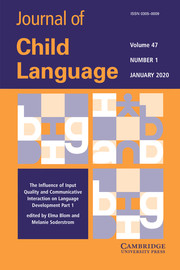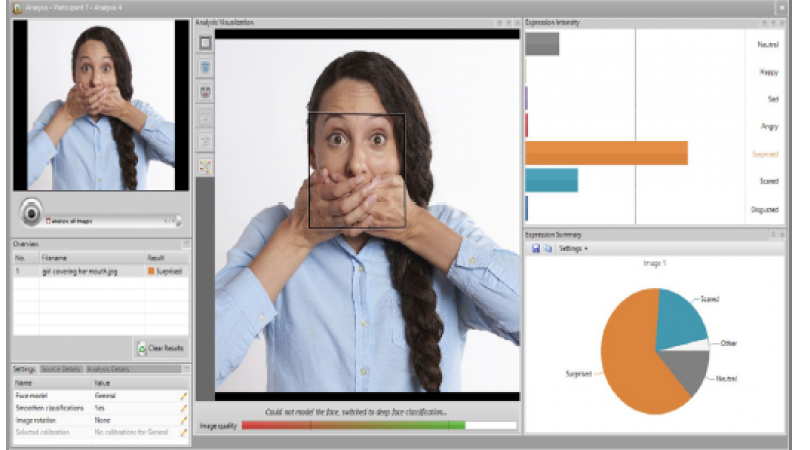【限时资源,期刊全文】Journal of Child Language(《儿童语言学杂志》) 2019论文集共60篇论文(侵删)
1561 阅读 13 下载 2020-06-24 18:14:00 上传 16.24 MB
本期推送的是SSCI收录的权威期刊——Journal of Child Language(《儿童语言学杂志》) 2019论文集,即第46卷共6期的60篇论文,其中目录可在正文中查看,全文可以点击文末附件列表下载,下载链接即
Journal of Child Language(《儿童语言学杂志》) 2019论文集-共60篇论文(侵删)
资料整理:张明辉(微信:zhangxiaojian160408)
(限时资源,即日起三天内下载有效,失效后请联系小编微信重新获取!)

| 卷号 | 期号 | 论文号 | 论文题目 |
| Vol. 46 | Issue 1 | Article 01 | Children's gradient sensitivity to phonological mismatch: considering the dynamics of looking behavior and pupil dilation |
| Vol. 46 | Issue 1 | Article 02 | Acquisition of weak syllables in tonal languages: acoustic evidence from neutral tone in Mandarin Chinese |
| Vol. 46 | Issue 1 | Article 03 | A multi-group approach to examining language development in at-risk learners |
| Vol. 46 | Issue 1 | Article 04 | Verb-based prediction during language processing: the case of Dutch and Turkish |
| Vol. 46 | Issue 1 | Article 05 | Toddlers map the word ‘good’ to helping agents, but not to fair distributors |
| Vol. 46 | Issue 1 | Article 06 | Prosody perception and production by children with cochlear implants |
| Vol. 46 | Issue 1 | Article 07 | An acoustic study of lexical stress contrastivity in children with and without autism spectrum disorders |
| Vol. 46 | Issue 1 | Article 08 | The effect of neighborhood density on children's word learning in noise |
| Vol. 46 | Issue 1 | Article 09 | The acquisition of English possessives by a bilingual child: Do input and usage frequency matter? |
| Vol. 46 | Issue 1 | Article 10 | Success in learning similar-sounding words predicts vocabulary depth above and beyond vocabulary breadth |
| Vol. 46 | Issue 2 | Article 11 | Subjective ratings of age-of-acquisition: exploring issues of validity and rater reliability |
| Vol. 46 | Issue 2 | Article 12 | Acquiring a first language in adolescence: the case of basic word order in American Sign Language |
| Vol. 46 | Issue 2 | Article 13 | Exposure and feedback in language acquisition: adult construals of children's early verb-form use in Hebrew |
| Vol. 46 | Issue 2 | Article 14 | Understanding how time flies and what it means to be on cloud nine: English as an Additional Language (EAL) learners’ metaphor comprehension |
| Vol. 46 | Issue 2 | Article 15 | Bilingual phonological acquisition: the influence of language-internal, language-external, and lexical factors |
| Vol. 46 | Issue 2 | Article 16 | Metaphor processing in middle childhood and at the transition to early adolescence: the role of chronological age, mental age, and verbal intelligence |
| Vol. 46 | Issue 2 | Article 17 | Processing of unfamiliar accents in monolingual and bilingual children: effects of type and amount of accent experience |
| Vol. 46 | Issue 2 | Article 18 | Interpreting physical and mental metaphors: Is Theory of Mind associated with pragmatics in middle childhood? |
| Vol. 46 | Issue 3 | Article 19 | The syntactic and semantic features of two-year-olds’ verb vocabularies: a comparison of typically developing children and late talkers |
| Vol. 46 | Issue 3 | Article 20 | Learning speech-internal cues to pronoun interpretation from co-speech gesture: a training study |
| Vol. 46 | Issue 3 | Article 21 | How do parents of school-aged children respond to their children's extending gestures? |
| Vol. 46 | Issue 3 | Article 22 | Examining the associations between children's receptive language skills and developmental domains in the United States and Turkey |
| Vol. 46 | Issue 3 | Article 23 | Do parents provide a helping hand to vocabulary development in bilingual children? |
| Vol. 46 | Issue 3 | Article 24 | Uh and euh signal novelty for monolinguals and bilinguals: evidence from children and adults |
| Vol. 46 | Issue 3 | Article 25 | The Italian Words and Sentences MB-CDI: normative data and concordance between complete and short forms |
| Vol. 46 | Issue 3 | Article 26 | Acquiring diminutive allomorphs: taking item-specific characteristics into account |
| Vol. 46 | Issue 3 | Article 27 | Not speaking the same language: 17-month-olds shift their perception of novel labels following brief exposure to non-native language |
| Vol. 46 | Issue 3 | Article 28 | Vocal production and novel word learning in the first year |
| Vol. 46 | Issue 4 | Article 29 | Novel word learning at 21 months predicts receptive vocabulary outcomes in later childhood |
| Vol. 46 | Issue 4 | Article 30 | Speech development in preschool children: evaluating the contribution of phonological short-term and phonological working memory |
| Vol. 46 | Issue 4 | Article 31 | The development of vocabulary and grammar: a longitudinal study of European Portuguese-speaking toddlers |
| Vol. 46 | Issue 4 | Article 32 | Examination of monolingual (English) and bilingual (English/Spanish; English/Urdu) children's syntactic awareness |
| Vol. 46 | Issue 4 | Article 33 | Testing language acquisition models: null and overt topics in Mandarin |
| Vol. 46 | Issue 4 | Article 34 | Differentiating scalar implicature from exclusion inferences in language acquisition |
| Vol. 46 | Issue 4 | Article 35 | Chinese preschoolers’ acquisition of temporal adverbs indicating past, present, and future: a corpus-based study |
| Vol. 46 | Issue 4 | Article 36 | Visual sequential processing and language ability in children who are deaf or hard of hearing |
| Vol. 46 | Issue 4 | Article 37 | Exploring the association of infant receptive language and pitch variability in fathers’ infant-directed speech |
| Vol. 46 | Issue 4 | Article 38 | Appreciating language conventions: thirteen-month-old Chinese infants understand that word generalization is shared practice |
| Vol. 46 | Issue 5 | Article 39 | The development of polite stance in preschoolers: how prosody, gesture, and body cues pave the way |
| Vol. 46 | Issue 5 | Article 40 | Print exposure predicts pronoun comprehension strategies in children |
| Vol. 46 | Issue 5 | Article 41 | The moderating effect of Korean preschoolers’ receptive and expressive language skills on the link between Korean PA and English PA |
| Vol. 46 | Issue 5 | Article 42 | A longitudinal investigation of language mixing in Spanish–English dual language learners: the role of language proficiency, variability, and sociolinguistic factors |
| Vol. 46 | Issue 5 | Article 43 | The blowfish effect: children and adults use atypical exemplars to infer more narrow categories during word learning |
| Vol. 46 | Issue 5 | Article 44 | Do bilingual children lag behind? A study of morphological encoding using ERPs |
| Vol. 46 | Issue 5 | Article 45 | The development of possession in the L1 acquisition of Northern East Cree |
| Vol. 46 | Issue 5 | Article 46 | The ecology of prelinguistic vocal learning: parents simplify the structure of their speech in response to babbling |
| Vol. 46 | Issue 5 | Article 47 | Children's understanding of pronouns that differ in scope of reference |
| Vol. 46 | Issue 6 | Article 48 | Phonological selectivity in the acquisition of English clusters |
| Vol. 46 | Issue 6 | Article 49 | Preschoolers are sensitive to accent distance |
| Vol. 46 | Issue 6 | Article 50 | The root nominal stage: a case study of early Nungon verbs |
| Vol. 46 | Issue 6 | Article 51 | Lexical and grammatical development in children at family risk of dyslexia from early childhood to school entry: a cross-lagged analysis |
| Vol. 46 | Issue 6 | Article 52 | The effects of the pronoun me on dative comprehension |
| Vol. 46 | Issue 6 | Article 53 | The acquisition and use of relative clauses in Turkish-learning children's conversational interactions: a cross-linguistic approach |
| Vol. 46 | Issue 6 | Article 54 | The cross-linguistic performance of word segmentation models over time |
| Vol. 46 | Issue 6 | Article 55 | Cues for word-learning during shared book-reading and guided play in preschool |
| Vol. 46 | Issue 6 | Article 56 | Walking, pointing, talking – the predictive value of early walking and pointing behavior for later language skills |
| Vol. 46 | Issue 6 | Article 57 | Dónde está la ball? Examining the effect of code switching on bilingual children's word recognition |
| Vol. 46 | Issue 6 | Article 58 | Learning to construct sentences in Spanish: a replication of the Weird Word Order technique |
| Vol. 46 | Issue 6 | Article 59 | Do children really acquire dense neighbourhoods? |
| Vol. 46 | Issue 6 | Article 60 | Reviewers 2019 |
所需积分:0 分
限期开放已结束
表情
图片
附件
相关推荐
推荐工具













